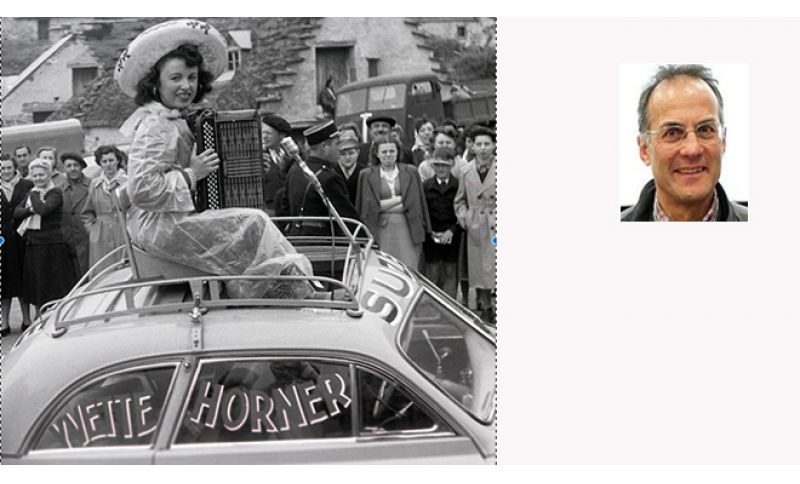

She rode eleven Tours de France. At the head of the group. Even at the head of the caravan. And she played for everyone. Yvette Horner was thirty years old and was an accordion player. She came from Tarbes, at the foot of the Pyrenees, a land of cycling and rugby - and this happy marriage can still be admired now in the grassy center of a roundabout at the entrance to the town where rugby goal posts are planted -, she grew up in Rabastens-de-Bigorre, about twenty kilometers from Tarbes, had studied in Tarbes, Toulouse, and Paris. In 1952, she climbed onto the Citroen Traction Avant advertising car for Calor, the brand of an electric iron, stood up on the back seat, towered through the open sunroof, embraced her accordion and began to play for the Tour de France. And everyone fell in love with her: spectators and riders.
Horner came from a family of artists: her maternal grandparents ran the Imperial Italian Theater. Yvette had started with the piano. It was her mother who steered her towards the accordion: she had intuited the strangeness, originality, and uniqueness of an accordion player. To make a living, Yvette performed in concerts and championships, on television, in movie theaters and casinos, on the advertising car - with a Mexican sombrero and flowing dresses - during stages and at the end of stages on the podium next to the winner. With an endless repertoire, from Bach to jazz, with contagious joy, by contract and not, with inexhaustible energy, like a forced road traveler. So much so that in 1954 she was hired to cheer up the Paris Track Six Days. And Yvette seemed like the portrait of happiness, even though the seven hours of daily concert, between fatigue (the instrument weighed about fifteen kilos) and jolting (up and down hills), could be felt deep in her bones. "I didn't even have the chance," she would confide, "to scratch my nose or shoo away mosquitoes". And she would continue playing after the stage, in the center of the town or city, sometimes until two in the morning. And the alarm clock at six the next morning. It is said that, after the Tour, she needed two months of rest in the Vosges to return to playing. Some measures were taken to alleviate her pain, such as playing on the roof of the car, even while seated. When they tried to replace her, occasionally, with a mannequin created in her image and likeness, like a doppelganger, the public was indignant and angry. In 2005, at an auction, that mannequin was nonetheless sold for 2,200 euros.
Yvette was such a success that her husband, René Dresch, a Bordeaux striker, quit playing football to become her driver on the road. She stepped down from the team car in 1965, Yvette Horner, but not from the stages. She experimented with the possible, playing with Boy George, collaborating with Maurice Béjart, wearing Jean-Paul Gaultier. It is said that in her 64-year career she gave two thousand concerts, recorded 150 albums, and sold 30 million records. At her first million, Jacques Anquetil was there to celebrate her. Oysters and champagne!, one can bet on it.
Yvette Horner died in 2018, she was almost 96 years old. Yes: she had played for everyone.

Se sei giá nostro utente esegui il login altrimenti registrati.